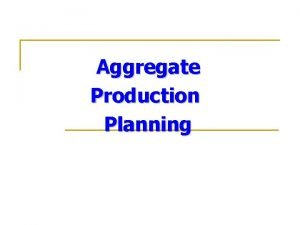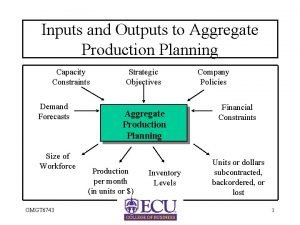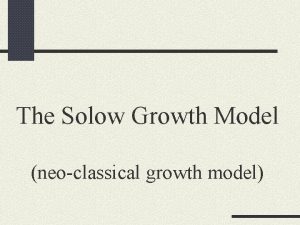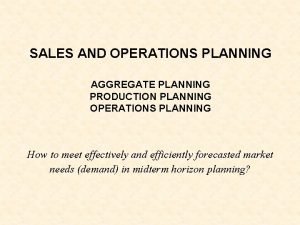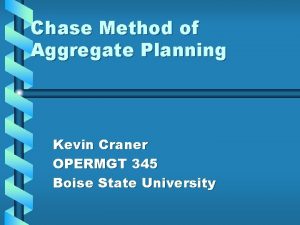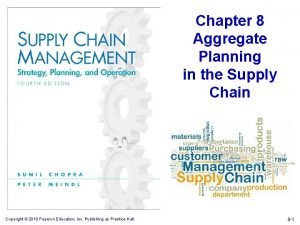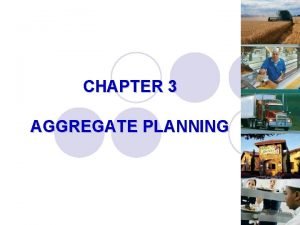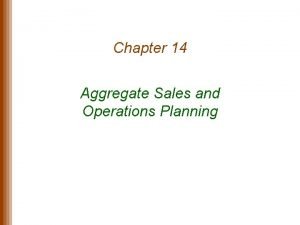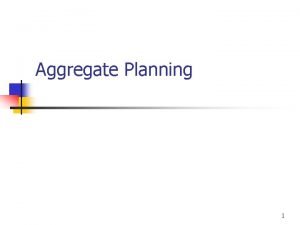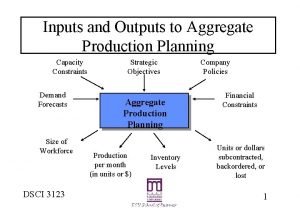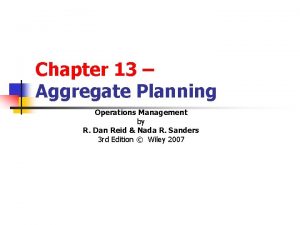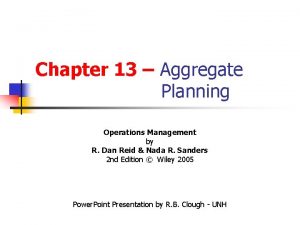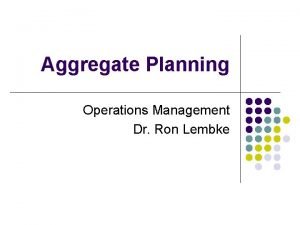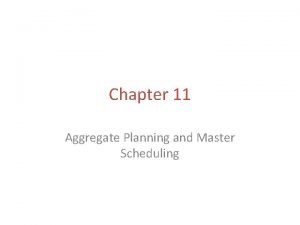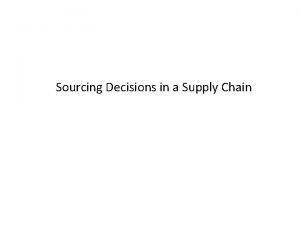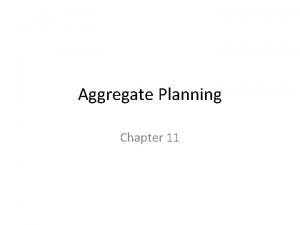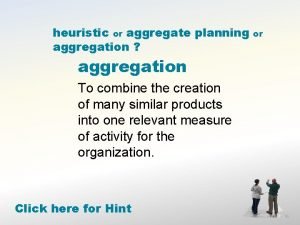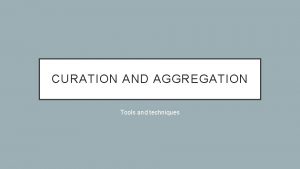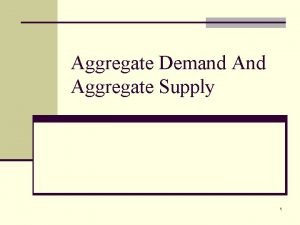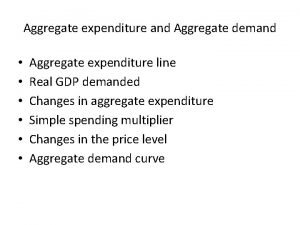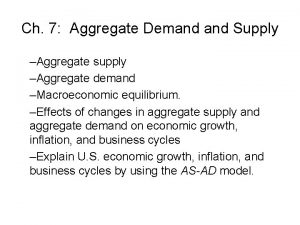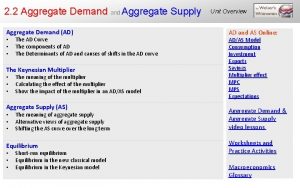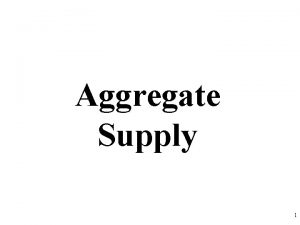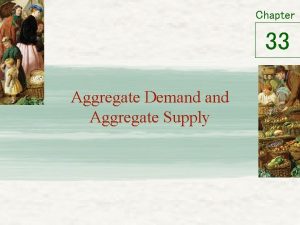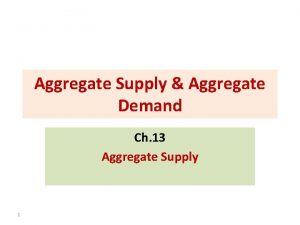Aggregate Production Planning Contents 1 What is aggregation



































- Slides: 35

Aggregate Production Planning

Contents 1 - What is aggregation? 2 - What is aggregate production planning? 3 - Importance of aggregate planning 4 - Aggregate planning inputs+ outputs 5 - Aggregate planning in services 6 - Matching capacity and demand 7 - Aggregate planning strategies 8 - Example of aggregate planning

1 - What is aggregation?

What is aggregation? n n n Aggregation refers to the idea of focusing on overall capacity, rather than on individual products or services, or bringing together under one plan, groupings of related products or services. For services : For services, aggregate planning refers to determining a staffing plan based on the following: q The scheduling of staff to meet or exceed customer service needs q Capacity requirements (machines, facility) For manufacturing: aggregate planning refers to determining a production plan based on the following: q Work force levels - the number of workers required for production q Production rates - the number of units produced per time period q Inventory levels - the balance of unused units carried forward from the previous period.

What is aggregation? n n n n n Aggregation is done according to: products, labour, & time: Products A product family (or product archetype) is a group of products that are manufactured similarly Have common labor and material requirements Do not focus on details, but on broad product families Labor Usually a specific plant is devoted to a given product family Time How often should an aggregate plan be updated? Disruption versus sudden demand changes and/or seasonality

2 -What is aggregate production planning?

What is the aggregate production planning? 1 - A “big picture” approach that does not focus on individual products or services. Instead, the focus is on groups of similar products of an entire product line. (Examples: - total number of bikes produced, and total number of customers served). 2 - Medium-term capacity planning over a two to eighteen month planning horizon. It involves determining the lowest-cost method of providing the adjustable capacity for meeting production requirements. 3 - An intermediate planning method used to determine the necessary resource capacity a firm will need in order to meet its expected demand 4 - Process by which a company determines levels of capacity, production, subcontracting, inventory, stockouts, and pricing over a specified time horizon. 5 - Process that translates annual business & marketing plans & demand forecasts into a production plan for all products in a plant or facility. § Focus on quantity and timing of expected demand (forecast) § Start with multiple plans and choose the most appropriate one depending on revenue, market share, and Inventory targets

Overview of Manufacturing Planning Activities

3 -Importance of aggregate planning

Why aggregate planning is necessary? n Operations and supply chain management q n To ensure that Operations is prepared to meet customer needs n Should make-buy decisions be changed? n Contracts for raw materials and parts n Labor requirements n Inventory levels Marketing q To ensure that the company's capacity will be used in the most profitable way, considering market constraints – If there is not enough capacity, which products or customers will have priority? q q n Accounting and Finance q q q n If there is more capacity than needed, how can the firm sell more? The aggregate operations plan and the sales Plan must be consistent To have an accurate budget for operations To ensure adequate cash flow for operations Year-end inventory levels affect earnings forecasts Human resources management q q If more workers will be needed, plan for hiring and training If fewer workers are needed, plan for layoffs

4 - inputs, outputs of aggregate planning

Aggregate planning inputs n A forecast of aggregate demand n covering the selected planning horizon (6 -18 months) n Constraints: n n limits on overtime, layoffs, capital available, stockouts or backlogs, company policy, financial constraints, capacity constraints The alternative means available to adjust short- to medium-term capacity, to what extent each alternative could impact capacity and the related costs Production costs: q q labor costs, regular time ($/hr) and overtime ($/hr) subcontracting costs ($/hr or $/unit) cost of changing capacity: hiring or layoff ($/worker) and cost of adding or reducing machine capacity ($/machine) Stockout or backlog cost ($/unit/period)

n n n Aggregate planning outputs Total cost of a plan Production quantity from regular time, overtime, and subcontracted time: used to determine number of workers and supplier purchase levels Inventory held: used to determine how much warehouse space and working capital is needed Backlog/stockout quantity: used to determine what customer service levels will be Machine capacity increase/decrease: used to determine if new production equipment needs to be purchased In brief outputs are the projected levels of : q Monthly production q inventory q Employment (size of work force) q Subcontracting q Backordering, and the costs of all these components

5 -Aggregate planning in services

Aggregate planning in services -Intangible products can’t be inventoried Possible approaches: - n q q Try to proactively shift demand away from peaks Use overtime or subcontracting to handle peaks Allow lost sales Cross train people to increase effective capacity Difficulties n n n n Services can not be inventoried Demand is difficult to predict Capacity is difficult to predict Service capacity must be provided at appropriate time and place Labor is most constraining resource Demand is perishable Input is highly variable

6 - Matching capacity and demand

Matching capacity and demand A- Adjusting capacity B- Adjusting demand

(A)- Modifying capacity

Strategies for modifying capacity n After existing and future capacity requirements are assessed, alternative ways of modifying capacity must be identified. n Short-term Responses: n For short-term periods of up to one year, fundamental n n capacity is fixed. Major facilities are seldom opened or closed on a regular monthly or yearly basis. Many short-term adjustments for increasing or decreasing capacity are possible,

Temporary capacity changes Type Action Inventories Stock pile finished goods during slack periods to meet later demand. Backlogs During peak demand periods, ask willing customers to wait some time before receiving their product. File their order and fulfill it after the peak demand period Employment levels Hire additional employees or layoff employees as demand for output increases and decreases. Work force utilization Have employees work overtime during peaks and be idle or work fewer hours during slack demand periods Employees training Instead of having each employee specialize in one task, train each in several tasks. Then, as skill requirements change, rotate employees among different tasks. This is an alternative to hiring and layoffs for getting needed skills. Process design Change the job content at each workstation to increase productivity~ Use work methods analysis to redesign-jobs. Subcontracting During peak periods, hire other firms temporarily to make the product or some of its subcomponents

Option Capacity (aggregate) options - advantages & disadvantages Advantage Disadvantage Some Comments Changes in human resources are gradual, not abrupt production changes Inventory holding costs; Shortages may result in lost sales Applies mainly to production , not service operations Varying Avoids use of other alternatives workforce size by hiring or layoffs Hiring, layoff and training costs Used where size of labor pool is large Varying production rates through overtime or idle time Matches seasonal fluctuations without hiring/training costs Overtime premiums, tired, workers, may not meet demand Allows flexibility within the aggregate plan Subcontracting Permits flexibility and smoothing of the firm's output Loss of quality control; reduced profits; loss of future business Applies mainly in production settings Changing inventory levels

Capacity (aggregate) options - advantages & disadvantages Option Advantage Disadvantage Some Comments Using part-time workers Less costly and more flexible than full-time workers High turnover/training costs; quality suffers; scheduling difficult Good for unskilled jobs in areas with large temporary labor pools Influencing Demand Tries to use excess Uncertainty in capacity. Discounts demand. Hard to draw new customers match demand to supply exactly Creates marketing ideas. Overbooking used in some businesses. Back ordering during highdemand periods May avoid overtime. Keeps capacity constant Customer must be willing to wait, but goodwill is lost Many companies backlog. Counterseasonal products and service mixing Fully utilizes resources; allows stable workforce May require skills or equipment outside a firm's areas of expertise Risky finding products or services with opposite demand patterns.

STRATGIES FOR MODIFYING CAPACITY n Long-term Responses: The costs, benefits, and risks of expansion pose an interesting decision n By building the entire addition now, the company avoids higher n n problem. building costs, the risk of accelerated inflation (and even higher future construction costs), and the risk of losing additional future business because of inadequate capacity. But there may also be disadvantages to this alternative: - First: the organization may not be able to muster the financial investment. Second: if the organization expands now, now it may find later that its demand forecasts were incorrect; if ultimate demand is lower than expected, the organization has overbuilt. n Finally, even if forecasted demand is accurate, it may not fully materialize until the end of the planning horizon. If so, the organization will have invested in an excess-capacity facility on which no return is realized for several years Since funds could have been invested in other ways, the organization has forgone the opportunity of earning returns elsewhere on its investment

(B)- Modifying demand

DEMAND STRATEGIES n n Regardless of the capacity expansion strategy used, a company will almost always benefit if it can satisfy the same total demand using less investment in capacity. A primary cause of underutilized capacity is short-term fluctuations in demand. Some products are highly seasonal, so that demand is very large during certain months of the yea days of the week, or even times of the day. If the capacity of the production system is designed to meet the maximum demand rates, a substantial amount of the capacity is unused during low-demand periods. Here we present strategic actions that can reduce a company's investment in production capacity without harming its ability to satisfy customer demand. Here we will discuss some the following strategies: 1 - Development of countercyclic but similar products 2 - Differential pricing and product promotion 3 - Capacity sharing

7 - Aggregate planning strategies

Aggregate Planning Strategies – main questions n n n Should inventories be used to absorb changes in demand during planning period? Should demand changes be accommodated by varying the size of the workforce? Should part-timers be used, or should overtime and/or machine idle time be used to absorb fluctuations? Should subcontractors be used on fluctuating orders so a stable workforce can be maintained? Should prices or other factors be changed to influence demand?

Aggregate Planning Strategies Three basic production strategies : - chase strategy, - level strategy, and - mixed production strategy

Extremes strategies Level Strategy Chase Strateg y Production rate is constant Production equals demand

Aggregate planning pure strategy Level Production Chase Demand Production Units Production Time

Chase Strategy - Adjusts capacity to match the demand pattern. Firm hires & lays off workers to match production to demand. Workforce fluctuates but finished goods inventory remains constant. - Works well for make-to-order firms q Produces exactly what is needed each period q Sets labor/equipment demands capacity to satisfy period

Level strategy Relies on a constant output rate & capacity (Workforce levels )while varying inventory & backlog levels according to fluctuating demand pattern. . Works well for make-to-stock manufacturing firms. q q q Sets capacity to accommodate average demand Produce same amount always Keep work force level constant Vary non-work force capacity or demand Often results in lowest production costs Maintaining a steady rate of regular-time output while meeting variations in demand by a combination of options.

Production planning techniques n n n Linear Programming Linear Decision Rule Computer Simulation Search Decision (Computer heuristic model) Tableau Method (transportation method) Trial and Error q Costing out the production alternatives and choosing the one with the lowest cost.

Developing the Aggregate Plan n n Step 1 - Choose strategy: level, chase, or hybrid Step 2 - Determine the aggregate production rate Step 3 - Calculate the size of the workforce Step 4 - Test the plan as follows: § § n Calculate Inventory, expected hiring/firing, overtime needs Calculate total cost of plan Step 5 - Evaluate performance: cost, service, human resources, and operations

7 - aggregate planning example
 Aggregate planning strategies advantages and disadvantages
Aggregate planning strategies advantages and disadvantages Material production schedule
Material production schedule Tahapan pre production
Tahapan pre production Perencanaan agregat ppt
Perencanaan agregat ppt List the strategic objectives of aggregate planning
List the strategic objectives of aggregate planning Examples of aggregate planning
Examples of aggregate planning Chapter 33 aggregate demand and aggregate supply
Chapter 33 aggregate demand and aggregate supply How to calculate aggregate demand
How to calculate aggregate demand Tableau cannot mix aggregate and non aggregate
Tableau cannot mix aggregate and non aggregate Unit 3 aggregate demand and aggregate supply
Unit 3 aggregate demand and aggregate supply Tax multiplier formula
Tax multiplier formula Unit 3 aggregate demand aggregate supply and fiscal policy
Unit 3 aggregate demand aggregate supply and fiscal policy Solow's model of economic growth
Solow's model of economic growth What is the aggregate production function
What is the aggregate production function Planning memorandum audit example
Planning memorandum audit example Contents of audit planning memorandum
Contents of audit planning memorandum Aggregate planning models
Aggregate planning models Level strategy aggregate planning example
Level strategy aggregate planning example Chase aggregate plan
Chase aggregate plan What is aggregate planning in supply chain
What is aggregate planning in supply chain Aggregate planning
Aggregate planning Aggregate planning excel
Aggregate planning excel Aggregate planning formula
Aggregate planning formula Transportation method of aggregate planning
Transportation method of aggregate planning Disaggregating the aggregate plan
Disaggregating the aggregate plan Aggregate planning
Aggregate planning Aggregate planning inputs and outputs
Aggregate planning inputs and outputs Aggregate planning strategies
Aggregate planning strategies Aggregate planning ppt
Aggregate planning ppt Chase strategy example
Chase strategy example Conclusion of aggregate planning
Conclusion of aggregate planning Aggregate planning and master scheduling
Aggregate planning and master scheduling Static diagrams in uml
Static diagrams in uml Uml private public
Uml private public Difference aggregation and composition
Difference aggregation and composition Tailored sourcing supply chain
Tailored sourcing supply chain
